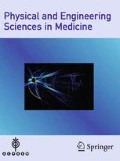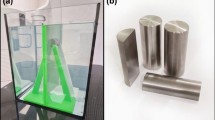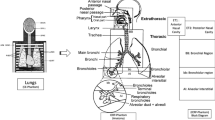Abstract
Many studies have performed dosimetric studies using various metal implants however these are difficult to translate to other implants of a different geometry or material (Rijken and Colyer, J Appl Clin Med Phys 18:5:301–306, 2017; Ade and du Plessis, J Appl Clin Med Phys 18:5:162–173, 2017; Prabhakar et al. Rep Pract Oncol Radiother 18:209–213, 2013; Ng et al. Rep Pract Oncol Radiother 20:273–277, 2015; Reft et al. Med Phys 30:1162–1182, 2003; Sasaki et al., Nihon Hoshasen Gijutsu Gakkai Zasshi 72(9):735–745, 2016). In this study, the ability of the Monaco Monte Carlo algorithm (Elekta AB, Stockholm, Sweden) to model radiation transport through different types of metals was evaluated. Investigation of the capabilities and limitations of the algorithm is required for the potential use of Monaco for planning radiotherapy treatments when avoidance of metal implants is clinically undesirable. A MapCHECK 2 diode array (Sun Nuclear Corp, Melbourne, USA) and a PTW 30013 Farmer chamber was used to measure the dose at depth, downstream of 1 cm × 5 cm × 5 cm metal blocks of three known compositions; stainless steel, aluminium and MCP96. The setup was imaged using a CT scanner and imported into the Monaco TPS where the beam arrangement was replicated. The density of the metals was overridden using the known electron density of each (IMPAC Medical Systems Inc, Monaco dose calculation technical reference. IMPAC Medical Systems, Sunnydale, CA, 2013). The differences between the dose measured using the ion chamber and calculated using Monaco downstream of the 1 cm metal blocks were respectively: − 1.2%, − 2.2% and 9.5% when irradiated using a 6 MV beam, and − 0.9%, − 1.3% and 14%, when irradiated using a 15 MV beam. This was then repeated using 2 cm and 3 cm of each metal type giving similar results for aluminium and stainless steel and increased discrepancy for MCP96. Discrepancies between treatment planning software and measurements at depth have been shown to give uncertainties between 5 and 23% in previous studies (Rijken and Colyer, J Appl Clin Med Phys 18:5:301–306, 2017; Ade and du Plessis, J Appl Clin Med Phys 18:5:162–173, 2017; Prabhakar et al. Rep Pract Oncol Radiother 18:209–213, 2013; Ng et al. Rep Pract Oncol Radiother 20:273–277, 2015; Reft et al. Med Phys 30:1162–1182, 2003; Sasaki et al., Nihon Hoshasen Gijutsu Gakkai Zasshi 72(9):735–745, 2016). This study uses basic shapes providing results that remove the uncertainties in geometry and can therefore be applied to any shape. This will help determine whether errors in dose calculations are due to the TPS particle transport algorithms or due to other effects, such as inaccurate contouring or incorrect densities. Thus giving the planner an additional degree of freedom in their planning and decision making process.


Similar content being viewed by others
References
Nicholas Ade FCP, du, Plessis (2017) Dose comparison between Gafchromic film, Xio, and Monaco treatment planning systems in a novel pelvic phantom that contains a titanium hip prosthesis. J Appl Clin Med Phys 18:5:162–173
Prabhakar R, Kumar M, Cheruliyil S, Jayakumar S, Balasubramanian S, Cramb J (2013) Volumetric modulated arc therapy for prostate cancer patients with hip prosthesis. Rep Pract Oncol Radiother 18:209–213
Ng WL, Brunt J, Temple S, Saipillai M, Haridass A, Wong H, Malik Z, Eswar C (2015) Volumetric modulated arc therapy in prostate cancer patients with metallic hip prostheses in a UK centre. Rep Pract Oncol Radiother 20:273–277
Reft C, Alecu R, Das IJ, Gerbi BJ, Keall P, Lief E, Mijnheer BJ, Papanikolaou N, Sibata C, Van Dyk J (2003) Dosimetric considerations for patients with HIP prostheses undergoing pelvic irradiation. Report of the AAPM Radiation Therapy Committee Task Group 63. Med Phys 30:1162–1182
Verhaegen F, Seuntjens J (2003) Monte Carlo modelling of external radiotherapy beams. Phys Med Biol 48:R107
Rijken JD, Colyer CJ (2017) Dose uncertainties associated with a set density override of unknown hip prosthetic composition. J Appl Clin Med Phys 18:5:301–306
Sasaki M, Nakata M, Nakamura M, Ishihara Y, Fujimoto T, Tsuruta Y, Yano S, Higashimura K (2016) Dosimetric verification around high-density materials for external beam radiotherapy. Nihon Hoshasen Gijutsu Gakkai Zasshi 72(9):735–745
Fippel M (1999) Fast Monte Carlo dose calculation for photon beams based on the VMC electron algorithm. Med Phys 26:1466–1475
Varian Medical Systems (2010) Acuros XB advanced dose calculation for the Eclipse treatment planning system. Varian Medical Systems, Palo Alto
IMPAC Medical Systems Inc (2013) Monaco dose calculation technical reference. IMPAC Medical Systems, Sunnydale
Khan FM (1994) The physics of radiation therapy, 2nd edn. Lippincott Williams & Wilkins, Baltimore, pp 176–177
Moutrie V, Kairn T, Rosenfeld A, Charles PH (2015) Use of a megavoltage electronic portal imaging device to identify prosthetic materials. Australas Phys Eng Sci Med 38:93–100
Acknowledgements
The IMRT evaluation program used was SNC Patient v6.5 supplied by: Sun Nuclear Corporation, Melbourne, FA, USA.
Funding
No funding was granted for this study.
Author information
Authors and Affiliations
Corresponding author
Ethics declarations
Conflict of interest
All authors declares that they have no conflict of interest.
Ethical approval
This article does not contain any studies with human participants or animals performed by any of the authors.
Additional information
Publisher’s Note
Springer Nature remains neutral with regard to jurisdictional claims in published maps and institutional affiliations.
Rights and permissions
About this article
Cite this article
Byrnes, K., Ford, A. & Bennie, N. Verification of the Elekta Monaco TPS Monte Carlo in modelling radiation transmission through metals in a water equivalent phantom. Australas Phys Eng Sci Med 42, 639–645 (2019). https://doi.org/10.1007/s13246-019-00749-2
Received:
Accepted:
Published:
Issue Date:
DOI: https://doi.org/10.1007/s13246-019-00749-2




